Nov. 2019: I passed through California for about five days.
(Observations about Southern California with pictures, and some springboarding off of them.)
Places I spent at least some time were: Van Nuys; the Santa Ana River trail in Orange County; Anaheim and “Anaheim Hills;” Orange (the city of); Santa Barbara. On a previous visit (late Aug. 2018), I went to Huntington Beach.
Leaving Southern California, north to Silicon Valley, I spent time in: San Jose; Palo Alto; the Stanford campus; Menlo Park; Redwood City. (Another post, maybe.)
_______________
Friday early morning. I arrive at the airport from points east (Korea, by way of a long layover in Hawaii) and am soon on the bus to LA Union Station. Or am I? I am not. I got on the wrong bus. It was not labeled. It came to the place marked LA Union Station; I decide to take this new opportunity. and follow the shuttle bus where it goes. New destination: Van Nuys.
Southbound from Van Nuys
The new plan was to walk to the Van Nuys Amtrak station to head down by train to Anaheim directly rather than stop in downtown Los Angeles first.
Arriving at Van Nuys, they collected people’s far and we got in. It took a while to so much as get out of the Van Nuys bus center. It is almost completely locked off from the outside world, except by car whereby you have to pay to get out. This is to say, though the sidewalk with open access to the rest of the world was not far off, there was no way to get to it as there are significant barriers (barbed wire fencing, walls) against all foot-traffic from coming in (or out). This locked-down nature of things is a condition I find characteristic of Southern California; I take solace at least in my stereotype being validated.
After much circling around, I manage to find the one possible way out, a distant way across one of the parking lots, a car entrance to a side-street not blocked off by a barrier in daytime. I go out.
From Van Nuys bus center to the Amtrak station on foot is not so far, but it’s unlikely many people ever walk it. The area in between is not bad-off. I cannot recall seeing anyone who was not Hispanic.
A billboard says “Homes End Homelessness.” A row of lampposts with the flags of Colombia, Mexico, Venezuela, El Salvador and others attached, two to each lamppost; are they always like this or is there some special event going on? A bus-stop wall with a large advertisement for “Richard Jewell,” a movie about the falsely accused 1996 Atlantic Olympics bomber, obscured by graffiti. Not much activity outside, except cars.
Now at the Amtrak station. Empty of employees, as far as I can tell. I had checked on the departure times for trains headed to Orange County, and my information was off; whereas I thought I had 20 or 30 minutes, the train was already here. I managed to get a ticket from a machine and hurried aboard. Destination: Anaheim.
Rolling south. The Amtrak conductor is a friendly white man in his 60s or so, who compliments me on making it onto the train at the last moment. I think he said, “You made it, buddy.” The conductor has that relaxed attitude and way of speaking I also think characteristic of the old California. It’s much different than you’d get from a conductor serving lines running through New York.
We pass through a few stations. One is Glendale. I recognize the name from a late-1930s-era Woody Guthrie song; Guthrie himself apparently set up shop in Glendale in the Dust Bowl era of the 1930s.
Here is a picture I took of the station from the window; the train station architecture is clearly going for an old-fashioned look:

Soon enough at Los Angeles Union Station. People on and off. Conductors change. Everything’s going smoothly, but not for long.
(At this same LA Union Station, a few days later on the way north to Santa Barbara, a Black man gets on the train and begins talking loudly, seemingly to himself, though as more people fill in empty seats he does finally get a seatmate, and starts talking to her, a middle-aged, low-English Hispanic woman. Within minutes of boarding, he gets into some kind of argument with the conductor. He spends the rest of his time on the train complaining about the conductor to all who will listen, and in colorful language. He at one point asks another train employee to see to it that the conductor gets fired. His erratic behavior is peppered by repeated use of the phrase “I’m just joking.” The Hispanic woman next to him agrees politely with everything he says when he asks for affirmation about how bad this one conductor is. He gets off at Oxnard, further up the coast.)
There is a long delay on the train just south of Los Angeles Union Station. A mechanical problem. We sit something like 90 minutes without explanation.
Not a good look for The Richest Country in the World. All too common.
(I recall the Nov. 2017 trip back from Roanoke, Virginia, by Amtrak, in which some kind of problem delayed the train by up to two hours. As I had plenty of time margin, I was not bothered on board as much as many. In the Roanoke trip, I was with my friend G.S., and we made light of the situation but agreed it would be terrible for anyone with an appointment. It was a Sunday.)
In a seat nearby, a girl in her 20s, white, previously buried in headphones or napping, gets on the phone to Amtrak headquarters and demands to be “comped” (in her word) for the ticket price. They seem to have told her to call back after completing her trip to shut her up. I wonder if she got her money back. I think of calling myself, later, to try to get a ticket credit, but never do. I am sure they would give me a hard time. A 90-minute delay should automatically entitle riders to a ticket credit, is an idea that crossed my mind.
The guy in charge of the snack car keeps getting on the PA system to tell passengers the snack car is closed because the train has lost power. After the first few times he lamely makes this same announcement, people start laughing whenever he comes back on. But this comedy of errors doesn’t last forever. Off we go.
Anaheim
The train pulls into Anaheim Station at 11:48am, about ninety minutes late. At this time of day, only Amtrak trains service the station, though later on many commuter trains come through.
Anaheim Station. Large, spacious, new-seeming, but little going on. It is easy to get out here and connect to the Santa Ana Trail, which I do. I am on my way, finally under my own power, to meet my friend James at the original appointed time in the afternoon.
James lives in either Anaheim or Anaheim Hills, depending on whom you ask. Where he lives is not hilly, so it fails qualifying for the latter on those grounds (so to speak). I did pass by some hilly areas to get to our meeting point, and they were wealthy (on which, more below). No wonder people might want to be associated with Anaheim Hills.
How I came to pass through California
On the way back to the US, the itinerary that formed itself allowed me to pass through California a while, one of my usual win-win travel arrangements (win by free extra travel, win by lowest price by being most flexible). The bargain-basement-priced way of returning from Korea to the eastern US this time was via an early-Friday (near dawn) arrival at LAX and a departure Tuesday late night from San Francisco. The plan came together, three days in Southern California and, then Santa Barbara, then a day in Silicon Valley. Minimal cost, minimal comfort. (I have always, up to this point in life, been more than willing to trade discomfort for price, plus you get to see more.)
I have mixed feelings, at best, about California, colored by what I have seen of it over the years and by the image I have developed about it from distant/passive observation. This trip was my first time in several places and as such impressions made tend to be strong. I hope I have reliably recorded some of them here. Back to the story:
Santa Ana River Trail
The Santa Ana Trail, a paved trail suitable for racing along in a bicycle, is excellent in design and should serve its purpose and be a model for others in the region. But 2010s-era problems with homeless “taking it over,” setting up permanent camps along it, are evident in several ways. Though they had been cleared out in various raids organized by Orange County in 2018 and 2019.
Anaheim is a German-like formulation translatable as “Home on the [Santa] Ana [River].” The Santa Ana River itself didn’t seem to have much water in it and was mainly dry in the places I saw, which added to the strange feeling of the place.
But for my purposes, it was ideal. For several hours I walked along it, heading north, to reach the place in eastern Anaheim at which I agreed to meet James in late afternoon, according to his schedule.
There are few people along the way this Friday afternoon. Those few I do see all seem to look at my with a suspicion I imagine to be uncharacteristically-Californian. Who is this guy with walking along with such a bag; is he another homeless interloper? Be wary.
I was aware enough of the homeless “takeover” problem of the late 2010s to be unsurprised by this reaction. I am thinking locals must have developed the habit of avoiding the trail. It runs all the way down to the Pacific up through Anaheim and beyond.

These kinds of signs are now up everywhere, after Orange County was pressured to crack down on homeless using the trail:

No camping,
No storing of personal property in recreational bike trail area
O.C.C.O 2-5-17(a).
The previous time I’d been to Anaheim, Aug. 2018, I did not approach it on foot. This time, I walked from Anaheim Train Station around seven miles upriver, then broke off into the neighborhoods and met James at a grocery store. I must say I prefer the walking method.
Off the trail and into hilly terrain, there are some fairly wealthy people with expensive homes. All of them seem to have security cameras. Few people are to be seen. On one particular long residential street on a hill, no one was around except a team or two of Spanish-speaking landscapers.
A typically palatial house I pass, one on the low-security side:
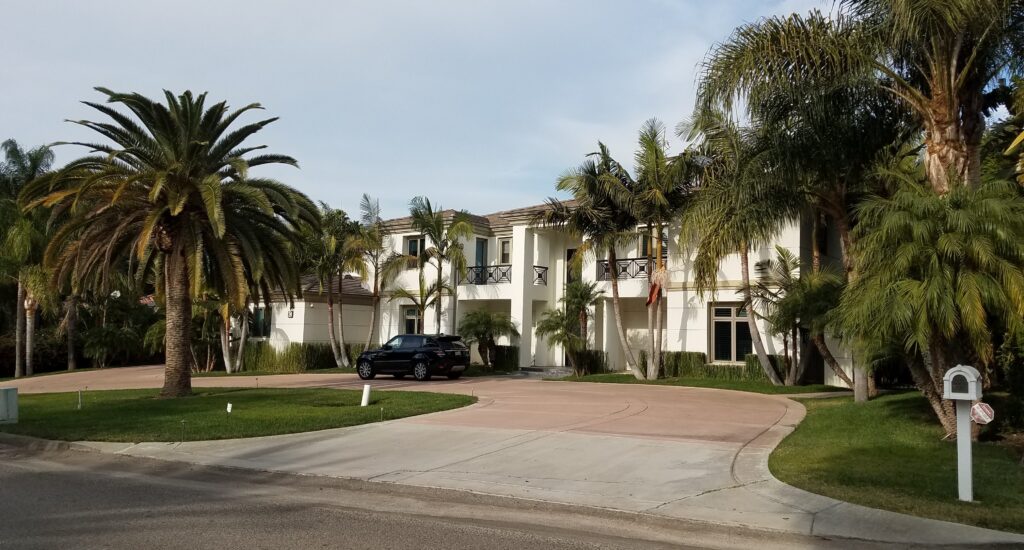
A lot of people seem to have the Ring security device which records everyone who comes to your door and provides a live feed you can monitor in real time from anywhere. In this and several other ways, mighty Southern California, with all its built-up prestige, is far from impressive. I speak of lived experience, not abstract GDP per capita or any other on-paper measure.
I think the simplest way to express this is the phrase “low trust.” I am guessing it was not always like this. But, then, I don’t know California. I visited at ages 8 and 12 in the 1990s, each time for a week, and a few incidental visits in the 2010s. Always some form of just passing through, be it half a day or a few days.
Lutherans in Orange County
There are a surprising number of signs of Lutheran presence I begin to see. Lutheran churches (more on which, below) and schools.
Maneuvering off the Santa Ana Trail and into the neighborhoods, the very first poster advertising something is for a fundraiser at Orange Lutheran High School (though their fundraiser was six weeks past and gone by this time):

The next definite Lutheran-related thing I see is in human form, my friend James, born and raised in Anaheim and lifelong Lutheran (his mother is of Latvian ancestry). He spent most of the 2010s in Korea, where I met him in 2012. We pass the next hour eating and talking. He had originally proposed to go to Disney Land but failed to get the free tickets he expected to be able to get. The alternate plan for the next day comes together.
Santiago Oaks Regional Park
The next day. James calls up a friend who suggests going to Santiago Oaks Regional Park. We go. Hiking all throughout and ascending to a point called Robber’s Peak. The final ascent is by my light insistence. James is hurting from the hike, but, like everyone who makes it to the top of a hill or mountain, he is glad he did it and is immediately energized for the way down.
We see a woman riding a horse and James (in hat) measuries how high he thinks a horse is compared to his own body height:

The park, really more what I would consider a series of “nature trails,” some of which are suitable for horses, some for mountain bikes, all for walkers like us.
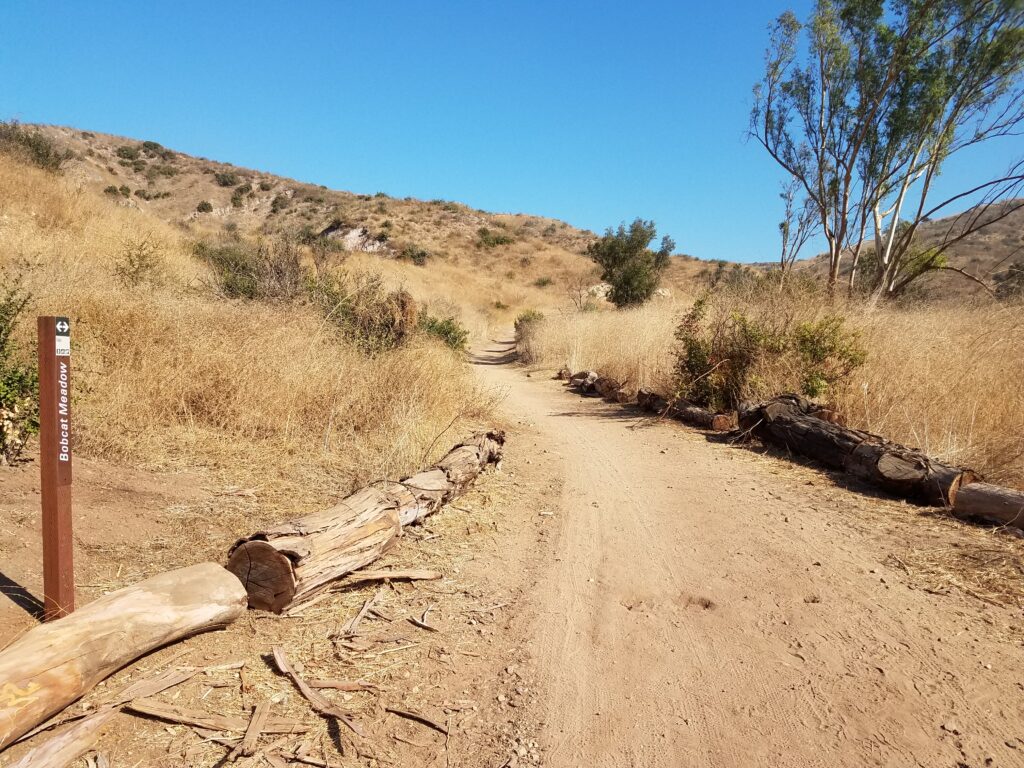

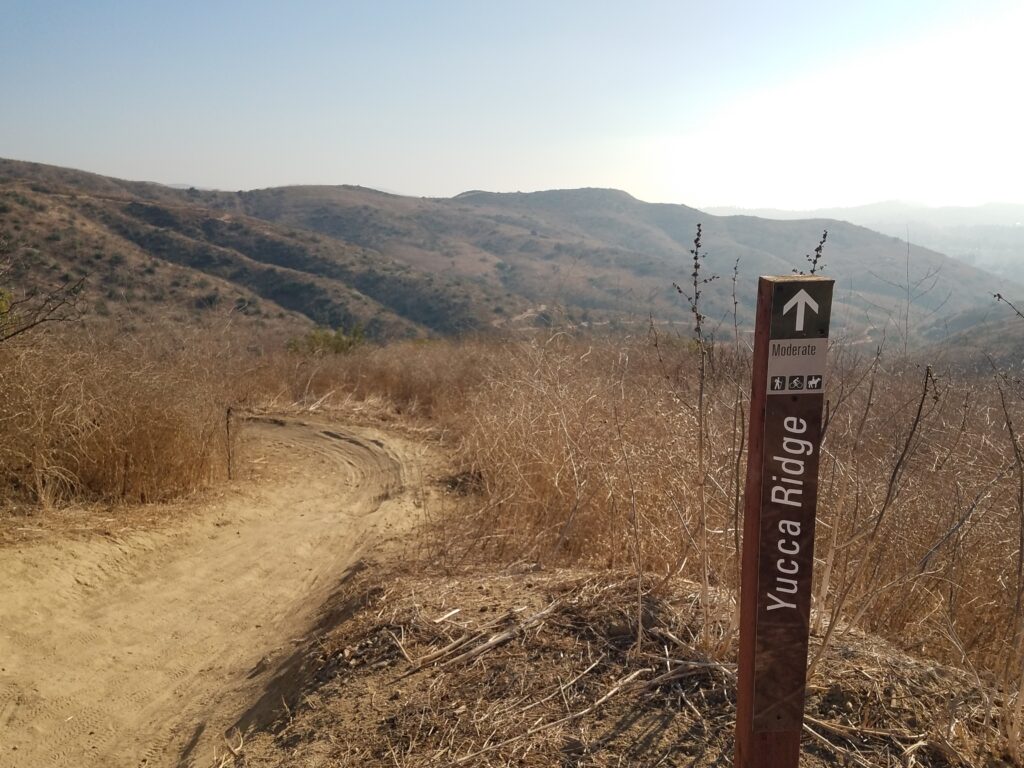
A propeller airplane, spotted:

Approaching Robber’s Peak:


At the very top, standing on the rock that sits at Robber’s Peak (which provides the cover that allows for its other name, Robber’s Roost):


But there are two rocks at Robber’s Peak. Both have graffiti. This is, it is said, because a technicality of where the border lines fall put the rocks just outside the park’s boundary, so no one is responsible for cleaning them clean.
It’s unclear to me when the name Robber’s Peak/Roost was first used, but the name is attributed to Mexican bandit leader Joaquin Murrieta, who active in California in the gold rush era and who, it is said, used the cover provided by the high ground and rock stage an ambush-roberry of one (or more) wagon trains.
Two people on the lower rock at Robber’s Peak:

Coming down:

A 1989 LA Times article invited people to visit Robber’s Peak (or Robber’s Roost), to “steal a last look at vanishing rural Orange County.”
This (looking north from high ground that ascends to Robber’s Peak), is what that writer foresaw thirty years earlier, and is what came to pass:

It all originally looked, more or less, like this (looking east, towards the core of the regional park):

Too many people. We looked up some of the home prices in the group of crammed-in townhouses seen above. They are expensive.
Off to “In & Out Burger”:

Of one thing I can be certain: California people love “In & Out.”
I met people in Korea who had lived in California, either native Californians or as medium- or long-term visitors (one Korean woman I knew lived there with her son so he could attend US schools for two years, a typical arrangement), and all of them seem to universally praise In & Out.
People’s praise for In & Out was never exactly the same. Different people would highlight different things. The price, the convenience, the taste, the old-style professionalism (staff seen to be unusually friendly) and the related fact that somehow the staff are young people from the local area (in contract to the well-known McDonald’s norm, and other fast food chains). But most of all it must be the taste and price combination.
The double burger is probably the best deal, at $4.36 after tax on my visit, for a total of 660 calories, including 37g of protein, 39g carbohydrate (from bread), and various vitamins; 11.7 cents per gram of animal protein for immediate service.
The weather report on the TV that night is more a fire-potential report. There was a lot of fire activity and power outages in 2019 in California.

At the Lutheran church
The next day, Sunday, the Lutheran theme returned in a strong way.
First of all we attended James’ church, a Lutheran church in eastern Anaheim with an unusual name. It is a large one, with probably a maximum seating capacity above 200. They have three Sunday morning services. The crowd was the usual Lutheran types you’ll find across North America.
I have written throughout this essay on occasions of my stereotypes being validated, but this one runs against my stereotypes: The crowd at this church does seem Middle America-oriented. This is the old Orange County of lore.
James and his siblings were brought up in this church (the “brought up” phrasing I recall his cousin using when I met her briefly on my previous visit), and at one point James himself had some kind of youth leadership position in this church.
I chatted a while with a man of James’ acquaintance named Brian, who looked, sounded, and acted uncannily like a coworker in 2019 at the think tank, down to having the same hair color, height, personality, vocal patterns, approximate age, and even name.
(In fact, we had two Brians during my time at the think tank in 2019; one left on the last day of July and one about the first week of September, so soon there were none. The one who looked and sounded like this Orange County Lutheran church guy is now studying for a PhD; the other one, who had a title with the word ‘senior’ in it, left for another job that pays more.)
Downtown Orange
In the afternoon we head to downtown Orange.
There are remnants of real (non-suburb-like) communities all across the Los Angeles County, Orange County, and other adjacent areas. “Downtown Orange,” as James called it, is one of these.
The whole Southern California region is, in general terms, a sprawling suburb that extends over several thousand square miles, and has been more-or-less that way for decades, certainly my entire life. But this late-20th-century ‘sprawl’ layer obscures some cohesive towns.

Downtown Orange feels like an old-style community, and it did originally grow up around the railroad. In thematic alignment with that fact, there are several antique shops of the bygone era, selling all kinds of the usual antique and quasi-antique trinkets:
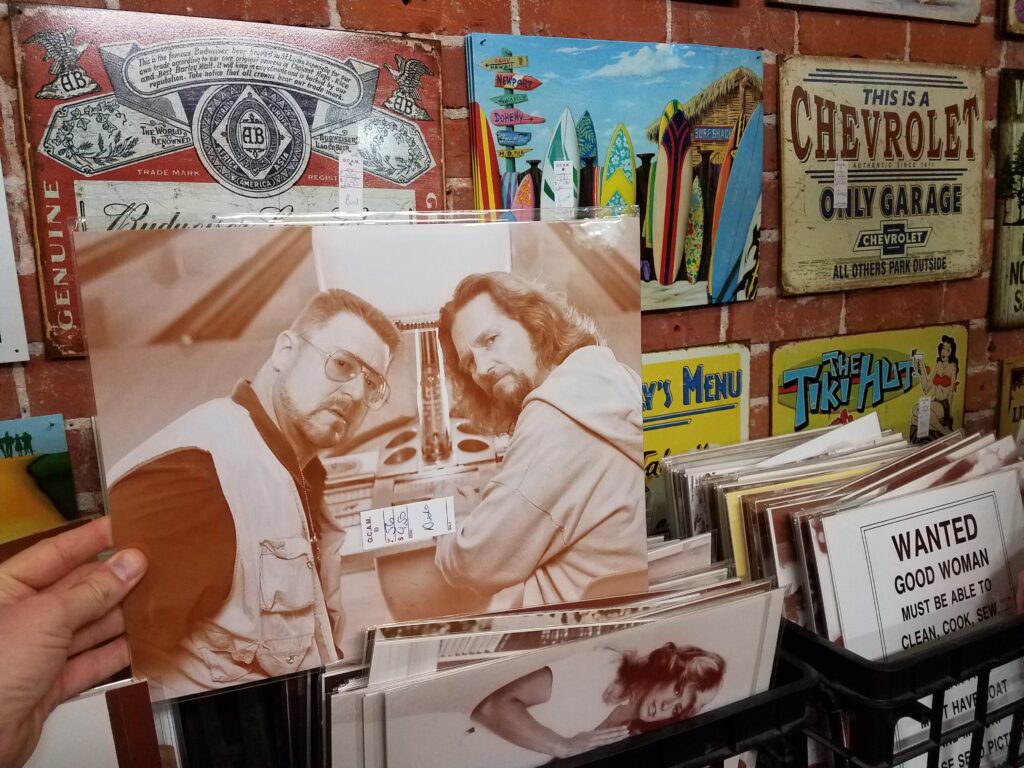
I find one (above) from The Big Lebowski, which might now qualify as an antique in the sense of being a nostalgia item. It is from 1998.
Much of the main antique emporium we looked around in reminded me of my b.1910s grandparents’ house in Iowa as it felt in the 1990s. In other words, a lot of things around that were held over from the mid-20th century, mixed with a few more recent things. An amateur (or non-amateur) historian’s treasure-trove.

I mention above the surprising number of Lutheran churches. There was at least one big one right near Orange Circle, at the center of downtown. This is again in line with the theme of Orange as a holdover of a real, old-line community. It points to the 20th century population stock in the area.
James pointed one out to me that he knew well, St. John’s Lutheran Church in downtown Orange:
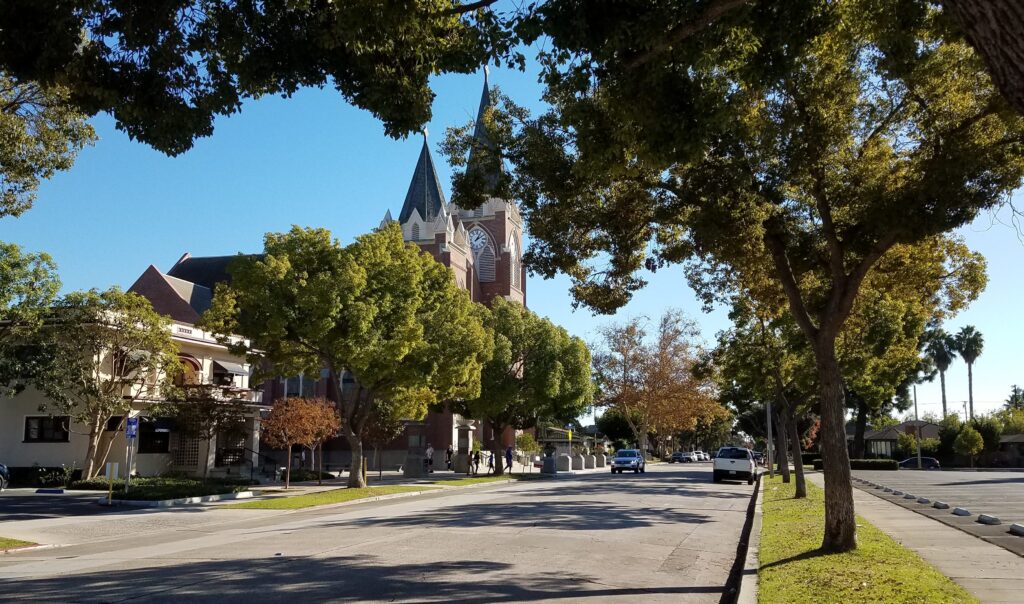


Yes, this is an old one.
It says Deutsche Evang.-Luth., St. Johannis Kirche 1913 [German Evangelical-Lutheran St. John’s Church, 1913]. I was surprised to see it was originally a German congregation and the above photo shows a connection to that identity; the cornerstone has clearly been refurbished or built anew, and the head pastor has a German name. That evening they were having a Bach concert, though what the occasion was on that Sunday, Nov. 17, I am not sure.
This kind of institution must also be a strong base layer of “the old Orange County of lore,” a phrase that occurred to me above in reference to the crowd at James’ church. And, fittingly for my point, Richard Nixon was born and raised in Orange County not far distant to the north at Yorba Linda the same year that this church was getting going; Nixon’s birth year (1913) is the same as the church’s.
James, having been there before, felt comfortable enough with St. John’s Church at Orange to suggest wandering inside. The inside is impressive:

A giant stained-glass window. It bears four inscriptions in German which are going to be hard to see digitally even in the best of conditions, so I will transcribe and translate them:
(top left)
Ich bin das Brot des Lebens
[I am the Bread of Life]
(top right)
Ich bin das Licht der Welt
[I am the Light of the World]
(bottom left)
Zum Gedächtnis an
[In memory of]
Karl Hemerick
(bottom right)
[Donated by] Frau Marie Hemerick
Who was Karl Hemerick?
I don’t know, but am curious.
A simple google search suggests there were/are some Hemericks in Southern California, but given that the dedication is in German and in the old Fraktur Gothic script, it must have been built in the early 20th century, around when the church itself was built (1913).
I have a long-standing genealogy hobby and in writing this have tried to use the sources I know to track down something on who Karl and Marie Hemerick may have been, going on the assumption that they were German-speaking Lutherans in Orange, California, in or about the 1910s.
The 1880 US census has a Charles Hemerick (age 34, born in Bavaria) and wife Marie Hemerick (age 32, born in Württemberg; possibly arrived in the US in 1874) in Deer Creek, Kansas, where Charles (or Karl) was a farmer. They lived next to the family Michael Hemerick (age 37), also a farmer and presumably Charles’ brother. The same Charles and and Marie Hemerick were still in Deer Creek, Kansas, in 1895 (Kansas State Census).
These names line up with the inscription; could they have moved west to Orange, California, in the late 1890s, 1900s, or 1910s? It could be. I can’t confirm it in the records and I can’t place a Karl or a Marie Hemerick, or a reasonable variant name, in Orange, California, at that or any other time. I’ll leave this mystery for someone else to solve. Or, someone in the St. John’s congregation may know. (I can only wonder how many people who have seen that inscription so far in the present century have asked, “Who was Karl Hemerick?”)
An LA Times article in early 1990 suggests something a little over 20% of the total white non-Hispanic ancestral-stock of Orange County was German as of the 1980s.
(The LA Times article was about a German cultural club, the Phoenix Club. It highlighted the club’s impromptu gathering and celebration on Nov. 10, 1989, at the scenes coming over the TV of the peaceful breach of the Berlin Wall that had occurred overnight. I see the Phoenix Club still exists as of 2020; I can only wonder how different it must be from the old-guard that probably still ran the show in 1990.)
I expect few of the congregants at that church today can even read the simple German phrases on that stained-glass window. The obsolete Fraktur-style script is one hurdle, and understanding the German is another.
Whoever Marie Hemerick was, and whoever the deceased Karl Hemerick was, the widow’s monument to the husband remains after a century, even if few can read it.
The railroad at Orange, I think looking in the direction of Los Angeles:
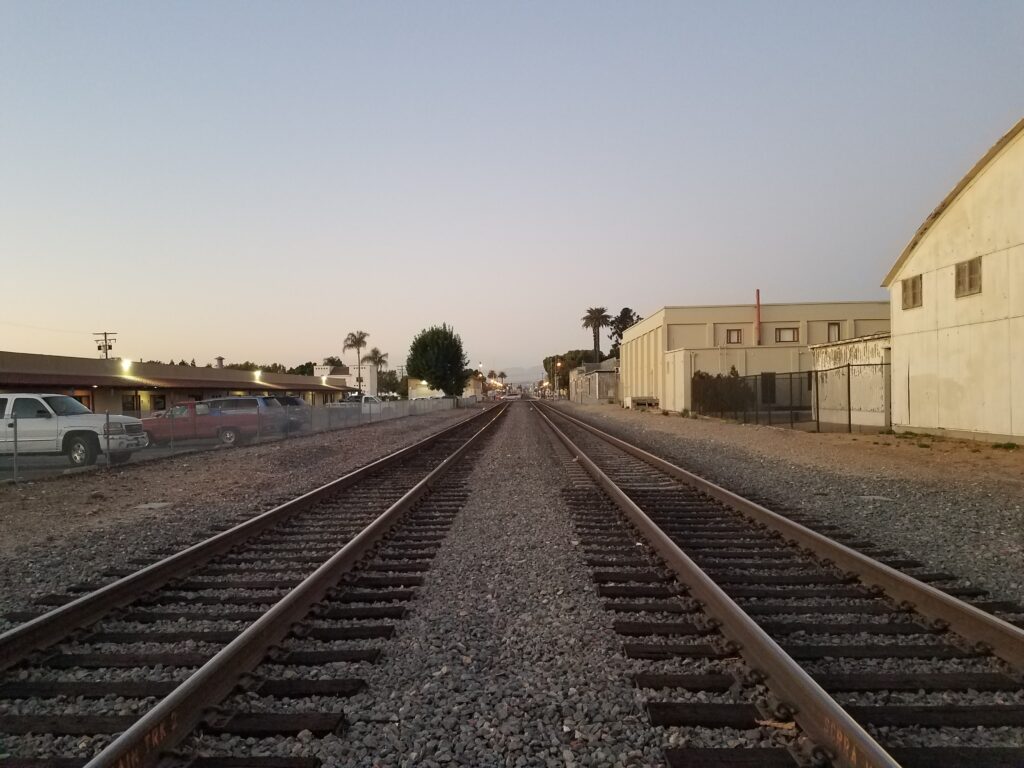
Next up, north to Santa Barbara.

I enjoyed this. Thank you.